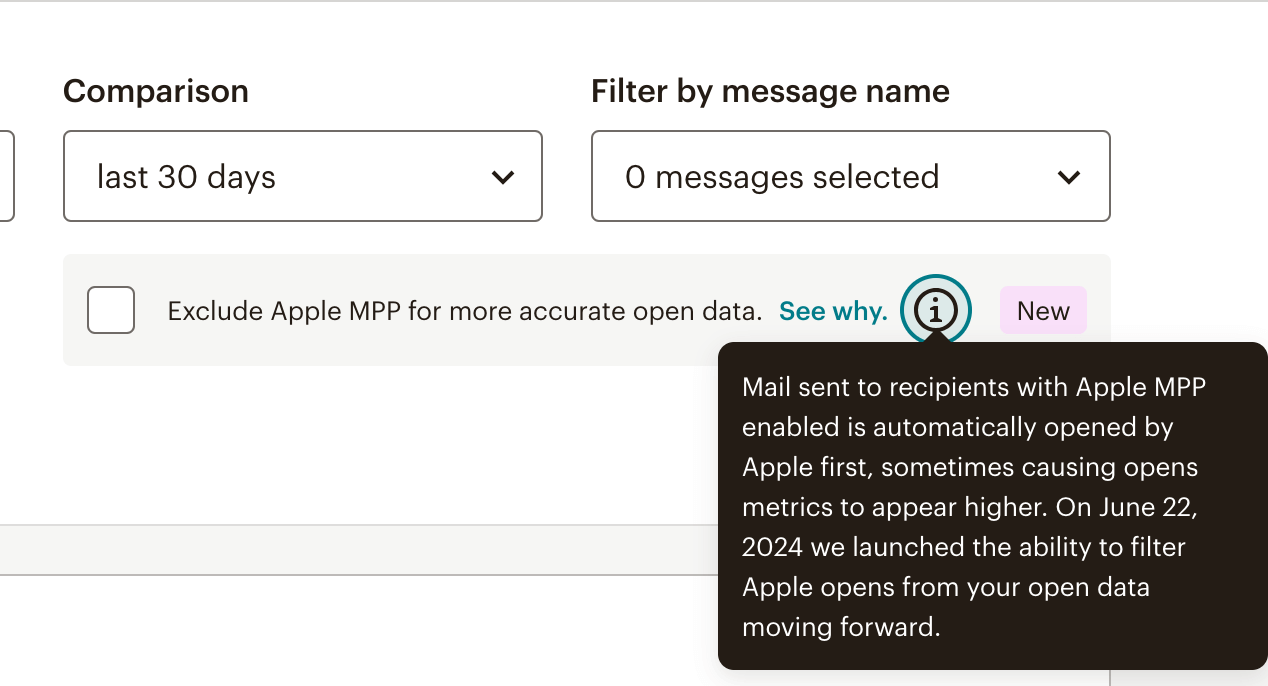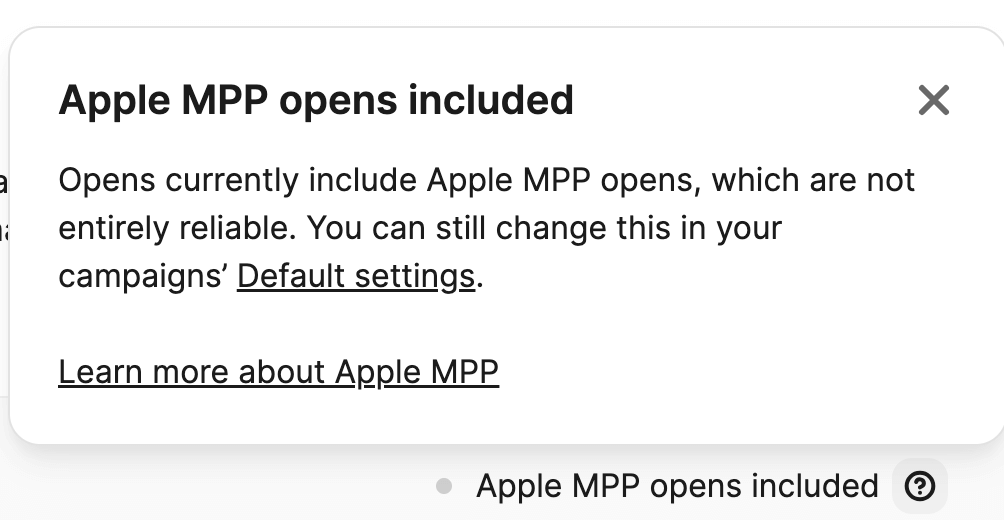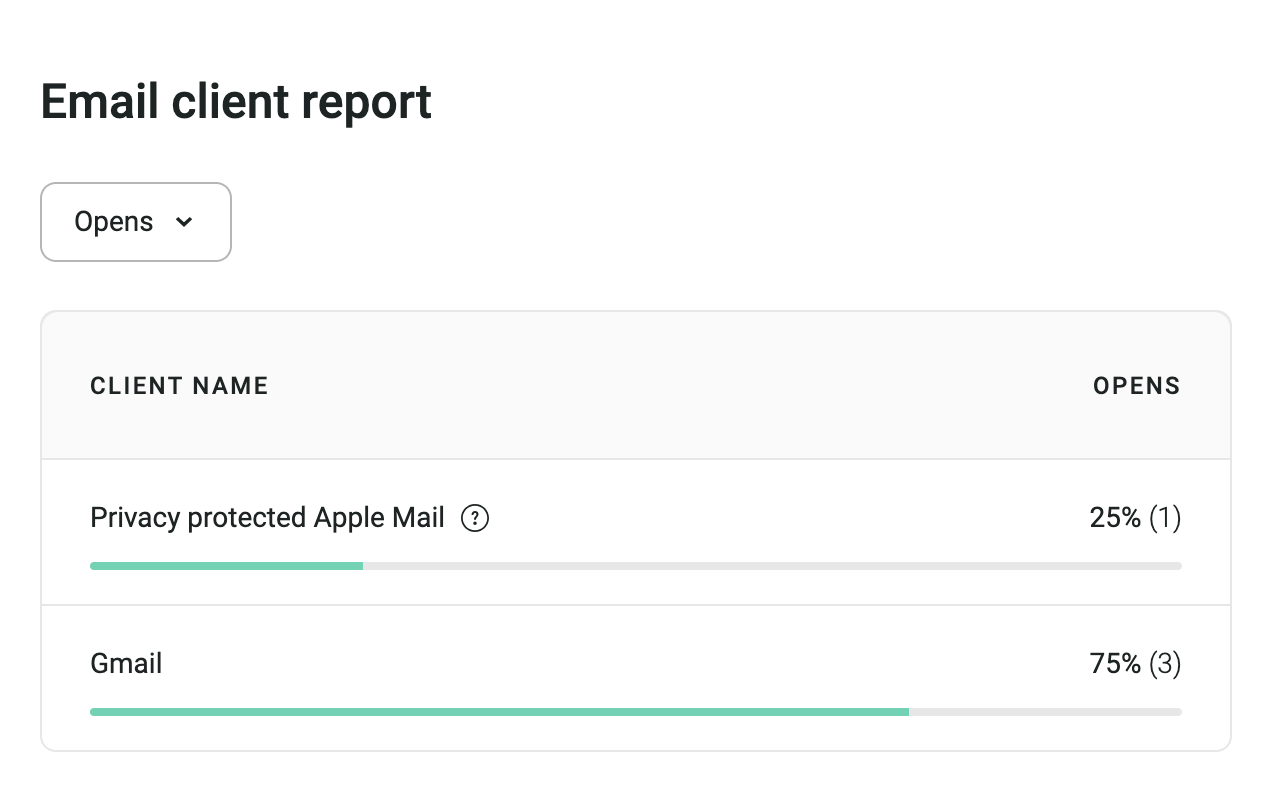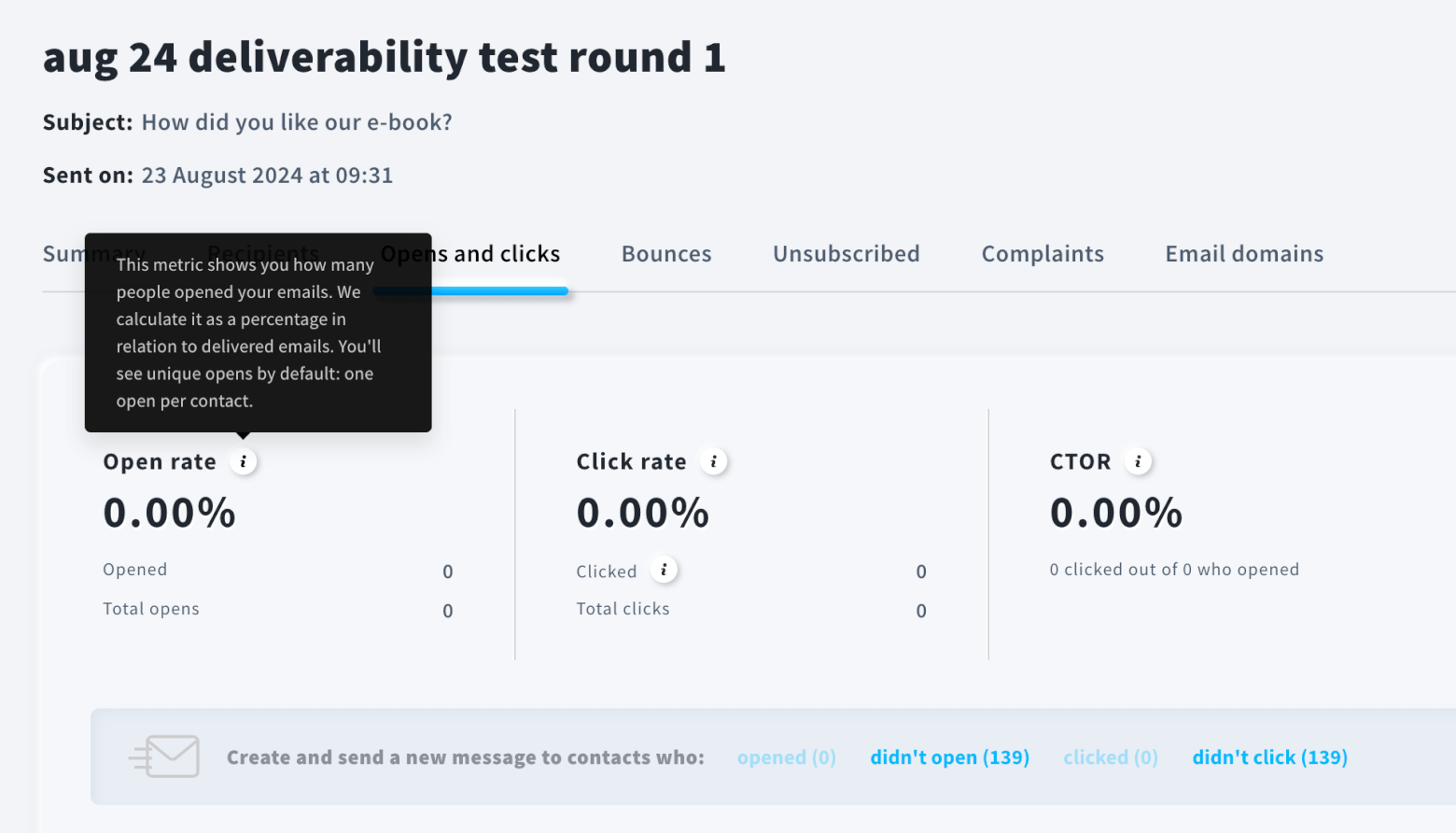More than three years have passed since Apple shook up the email marketing world with Mail Privacy Protection (MPP) – a change that left marketers scrambling to rethink their strategies.
Apple Mail users could now block senders from accessing their location data, and let Apple Mail hide whether or not they actually opened them – leading to open rates that were falsely inflated.
As a result, marketers had to adapt to a new reality where their reporting was no longer fully reliable – and, in many cases, had to completely change the way they ran their email marketing campaigns.
Despite the time that’s passed, the email marketing industry still hasn't reached a consensus on how to account for these gaps in their reporting. Here at EmailTooltester, we’ve seen email service providers (ESPs) adopt widely different approaches when it comes to Apple MPP open rate tracking, from automatically excluding Apple MPP opens from their reports, to ignoring their existence – and the problems they pose – completely.
This inconsistency makes it harder for marketers to compare performance and adjust their strategies effectively. So, to better understand the options available to marketers, let’s take a look at what each of the most popular ESPs is doing to account for Apple MPP open rates in their reporting.
Apple MPP Open Rates: Why They’re a Big Problem for Marketers
Introduced in September 2021, Apple's Mail Privacy Protection (MPP) prevents senders from knowing if and when an email is opened by hiding IP addresses and preloading email content. This means that even if an Apple MPP user doesn't actually open an email, it will still appear as opened in the sender's analytics.
This is particularly problematic because Apple Mail holds a substantial share of the email client market. According to Litmus, Apple accounted for 49.29% of email opens in January 2025, making it the most popular email client. While this can vary from company to company, it's still likely to represent a significant portion of your opens.

For one of EmailTooltester's recent newsletters, Apple MPP opens accounted for around 27% of total opens
Traditionally, marketers have relied on open rates to gauge the success of their campaigns, especially in comparison to previously sent emails. However, with MPP “faking” email opens, it’s now difficult to assess whether audiences are really engaging with emails or not. This complicates marketers’ efforts to refine content strategies, segment audiences, and measure the effectiveness of email marketing initiatives.
It also doesn’t help that ESPs have handled Apple MPP reporting in very different ways. So, let’s take a closer look at what each one is (or isn’t) doing to help marketers get a more accurate picture of their campaign performance.
How Each ESP is Tackling Apple MPP Open Rate Tracking
MailChimp
The world’s most popular email marketing platform offers a way to exclude Apple MPP opens from their reports, although it came a little late to the party. For users, the solution is simple enough: their marketing dashboard now has a check box to exclude MPP opens from their reports. The bad news? These can only be applied to emails sent on or after June 22, 2024.

In short: it took nearly three years for MailChimp to allow users to filter out Apple MPP opens in their reporting. And even now, they’ve taken a bare-minimum approach, as it doesn’t seem like they’ve given much consideration to how this could affect other areas, such as automations or email resends.
For example, rather than preventing Apple MPP openers from entering into automations, they simply recommend that marketers use different automation triggers, like clicks or purchases, instead. So if you have automations set up using “Opened email” as a trigger, it’s possible that Apple MPP users who never opened emails are being entered into these automations – and being overwhelmed with emails as a result.
To me, MailChimp’s delayed response to Apple MPP feels like a missed opportunity. Given how much of a headache inflated open rates have been for marketers, they could have been more proactive in helping to filter out MPP opens much sooner.
ActiveCampaign
ActiveCampaign is known for offering some of the most advanced reporting in an email marketing platform. They also happen to have the most carefully thought-out policies when it comes to Apple Privacy open rate tracking.
Like Mailchimp, ActiveCampaign initially filtered out Apple MPP opens by default, offering a more conservative estimate of campaign performance. However, they decided to change this policy in August 2022 after listening to customer feedback (where we suspect too many customers complained about open rates being too low).

Image source: Reddit
As a result, Apple Privacy opens are now included in their open rate reporting. This can be filtered out for each report by checking the “Include Apple Privacy opens” box:

By default, you will also be able to see Apple Privacy Opens as a separate line item in your report summary:

Their help documentation provides more detail around how they treat Apple Privacy opens in specific scenarios:
- The Apple Privacy filter can be applied to 6 different types of reports: All Campaigns, Campaign Overview, Campaigns Performance, Opens/Reads Trends, Automations Overview, and Automations Performance
- If Apple Mail MPP users click a link in an email, ActiveCampaign will record that as an open (on the basis that they would have had to open the email to click the link)
- Apple MPP Opens can’t be used as triggering events within automations, or in split test calculations based on open rates
- Similarly, contacts with MPP opens cannot enter into segments that use conditions such as “Has/has not opened any campaign”, or be re-sent emails using the “Resend a campaign” feature if the re-send criteria is based on open activity.
- ActiveCampaign will also exclude Apple MPP opens from its Engagement Management Tool, which lets you remove all “Unengaged” contacts from your list.
Compared to other ESPs, ActiveCampaign seem to have a much better handle on how customers expect Apple MPP opens to be treated, and are a lot more proactive in helping customers adapt their campaigns accordingly.
Brevo
Brevo appears to have followed a similar path to ActiveCampaign – albeit with a couple of years’ delay. Like ActiveCampaign, they used to automatically exclude Apple MPP opens when calculating the open rate, and as an alternative, provided an estimated open rate based on their own data.
However, on February 6th, 2025, they decided to no longer exclude Apple MPP opens from campaign reports by default:

That means that open rates now include Apple MPP opens – and if you want to exclude them, you have to manually tick that option in your settings:

As Brevo users ourselves, this change took us by surprise – and had we not seen the little popup notification informing us of this update, we might have been scratching our heads as to why our open rates were suddenly so much higher. But it seems like they received similar feedback as ActiveCampaign: when Apple MPP opens were excluded by default, Brevo customers complained that their open rates were lower compared to other platforms.
If you’re a Brevo user and weren’t aware of this change, make sure to adjust your settings if you want to exclude Apple Privacy opens from your reporting.
Klaviyo
This Shopify-backed email marketing platform was another service that was quick to adapt to Apple’s changes, implementing Apple MPP filtering features just a couple of months after. With Klaviyo, you are able to:
- Identify and create segments of Apple MPP openers, to exclude them from campaigns and other segments
- Remove Apple Privacy opens from attribution reporting
- Configure custom reports to track Apple Mail Privacy Protection (MPP) opens

Klaviyo lets you create segments to find Apple Privacy Opens (Image Source: Klaviyo)
The main caveat, however, is that Apple MPP opens are not excluded from campaign reports by default. To exclude them from your reporting and open rates, you would need to set up custom reports.
Omnisend
Like Klaviyo, Omnisend is another ecommerce-focused marketing platform. While they’ve also taken a number of steps to provide users insight into Apple MPP opens, they’re far from being extensive.
The first is that, within individual campaign reports, you’re able to see the number of opens driven by Apple MPP users:

However, these are still counted towards the overall open rate – there’s no way to exclude these from your reporting (unless you calculate them manually).
Omnisend’s Campaign Booster feature, which re-sends emails to those who didn’t open them the first time, now automatically excludes Apple Mail clients. In terms of attribution reporting, Omnisend now also allows you to choose either opens or clicks as the defining event for whether orders get attributed to Omnisend emails.
Although not directly related to Apple open rate tracking, Omnisend also introduced a new segmentation criteria, “View page”, within their segment builder. This allows users to use page views to trigger new automations, placing less of a reliance on opens as a signal of engagement.
Kit
Although Kit is widely used by creators and entrepreneurs – users who need to be closely attuned to their audience’s engagement habits – it comes up short when it comes to reporting on Apple MPP opens. With Kit, there is no way to identify or exclude Apple MPP opens from your campaign statistics.
In fact, in its help documentation, it doesn’t even list Apple MPP as a potential reason for why emails might be opened automatically. (Note: the only time it appears to exclude Apple MPP opens is when calculating newsletter ad impressions, although Kit Ads is a feature that’s currently restricted to a select number of users.)
It’s not exactly a proactive approach. Instead, Kit seems to be putting the onus on marketers to move away from using open rates as a measure of engagement, and focus on metrics like clicks as an alternative. While this may be a valid argument, it’s important to note that click rates aren’t always accurately reflected in reporting either – especially when Kit doesn’t offer a way to exclude bot clicks from reporting.
Reporting has never been a strong suit of Kit’s, and while the fact that they don’t treat inaccurate metrics as a bigger issue is disappointing, it’s not entirely surprising. Let’s see if that changes any time soon.
GetResponse
GetResponse is an email marketing platform that has always been big on features, offering niche tools like webinars, a course creator, and a conversion funnel. However, it doesn’t seem to give reporting the same amount of attention – like Kit, it doesn’t allow you to view or filter out opens driven by Apple MPP.
As you can see, their campaign reports make no mention of Apple MPP and its potential effect on open rates at all:

Their documentation isn’t much more helpful. Rather than fully addressing the broader impact of MPP, they simply suggest workarounds such as focusing on link clicks, leaving marketers to figure out the best approach on their own.
MailerLite
In a similar vein to Kit and GetResponse, MailerLite appears to have done little to help users improve the accuracy of their open rates. Their knowledge base simply states the following:
“While Apple Mail Privacy Protection may affect your campaign reports, it will not affect your deliverability. If you have a lot of Apple users on your subscriber list, we recommend disabling opens tracking or temporarily excluding them from campaign types that rely on opens to function such as A/B tests and auto resend campaigns.”
The Bottom Line? It’s Time to Move Beyond Open Rates
With nearly half of all email opens coming from Apple Mail, the impact of MPP on email marketing is undeniable. Yet, as we’ve seen, ESPs vary widely in how they handle Apple MPP opens – some offer filtering options, while others ignore the issue altogether.
Open rates are becoming increasingly unreliable, and while they’re fine to use in comparison with other campaigns, marketers should ultimately be shifting their focus to more meaningful engagement metrics. Clicks, conversions, and even page visits provide a much clearer picture of audience interest and intent.
If your ESP offers Apple MPP filtering, enabling it can help improve reporting accuracy, but ultimately, moving beyond open rates will make your email strategy more resilient in the long run.
Our Methodology
This article has been written and researched following our EmailTooltester methodology.
Our Methodology

